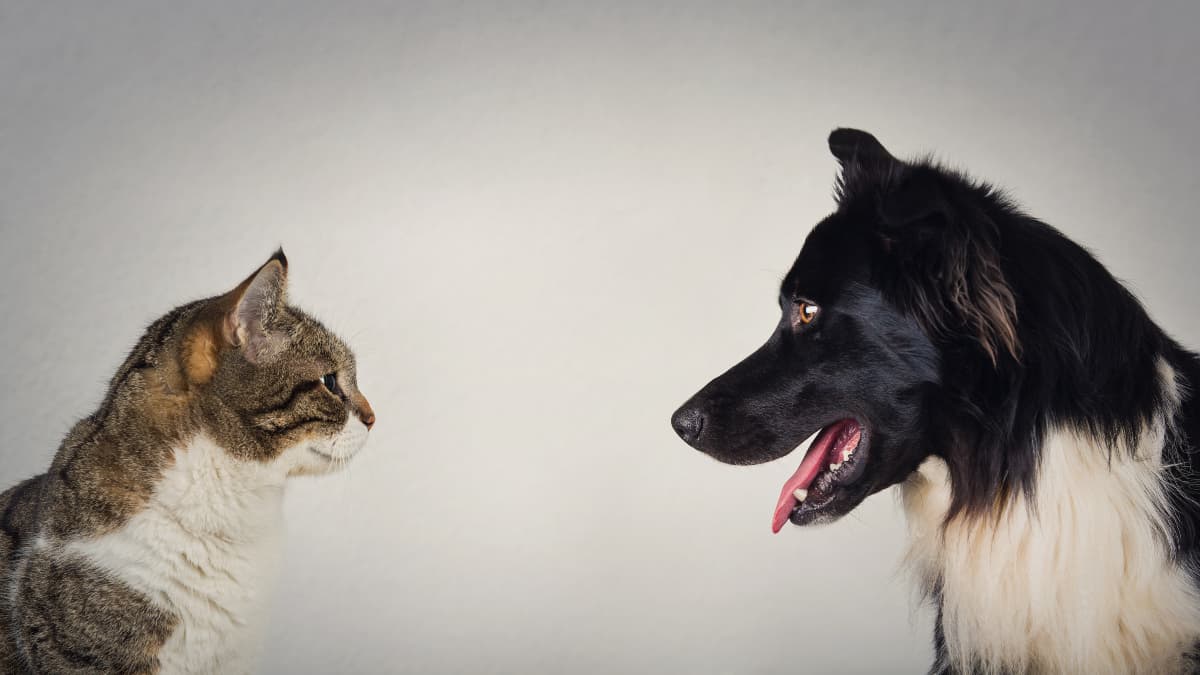
Are dogs and cats destined to be mortal enemies or can they learn to get along? Learn how to introduce dogs and cats successfully so they become friends or at least roommates.
As a pet owner, you probably know that the personalities of your furry friends differ significantly. Some dogs and cats live as best friends, others manage to find a balance based on tolerance, and a few simply cannot co-exist in the same household.When you introduce dogs and cats for the first time, it’s important that you take the appropriate steps to help set a foundation for future peace.
Like all cat or dog training techniques, understanding how your pet will react and the best ways for you to respond will help make this process easier for everyone involved.
Body Language of Dogs and Cats
Do you understand your pet’s body language? When you first introduce a cat to a dog or vice versa, you want to pay close attention to the body language of both creatures, as they can indicate if either pet is feeling happy, nervous, threatened, or aggressive.
Familiarize yourself with common dog and cat body language signals. They can help you gauge the situation so that you can appropriately react or not react to your pets. Position yourself so that you can step quickly in if necessary to take control of the situation before things take a turn for the worse.
Cat Body Langauge Red Flags
Cats are often more nervous when meeting a dog than the other way around. Dogs are usually bigger and less tactful, so your cat might be the first one to show hesitation. Look for common signs of anxiety or fear.
A cautious cat will often pin his ears back against his head and his tail will start flicking rapidly back and forth. The feline mannerisms mean that your kitty is upset and not being receptive to the canine newcomer. You might have to retreat and try again the next day after your kitty calms down.
Those are just a few behaviours and movements that can indicate that your cat is not enjoying this first contact with your dog. Take a look at some other signs your cat feels threatened, nervous, or frightened:
-
- Arched back
- Crouching
- Ears flattened
- Tucked tail
- Hiding
- Hissing
- Positioning the body sideways
- Raised fur along the back and tail
- Arched tail
Cats can lash out when they feel like a threat is increasing. Avoid fast or sudden movements that might further spook your cat. A better alternative for separating the two animals if the tensions are rising is to remove your dog from the room. This will give your cat a chance to relax so you can approach her safely.
Dog Body Langauge Red Flags
Some dogs might be more open to a new friend but don't always know how to approach them. If a dog approaches too eagerly, they could catch some attitude from your cat. which could lead to an escalation of tension for both animals. Monitoring your dog's actions and body language can help you predict their behaviour and allow you to adjust or intervene.
Another factor that could lead to a more difficult first meeting is that many dog food breeds are known to have a high prey drive (the need to seek out, chase, capture and kill prey is written in their DNA). This requires a slow and monitored acclimation to a new feline friend.
If the dog focuses strongly on the cat from the start, then watch closely. The dog may or may not bark or whine at the cat. The pooch might even start trying to stalk the cat like a wolf hunting its prey. At this point, do not let the dog near the cat.
Dogs can show signs of fear, anxiety, and aggression in many ways. Recognizing these signs is helpful when determining how to introduce dogs and cats. Here are some signs that your dog feels uncomfortable or threatened:
-
- Avoiding eye contact with the cat and looking away
- Lip licking
- Yawning repeatedly
- Ears held back against the head
- Growling
- Raising a paw
Here is a helpful graphic to help you visualize some of the most common dog body language cues:
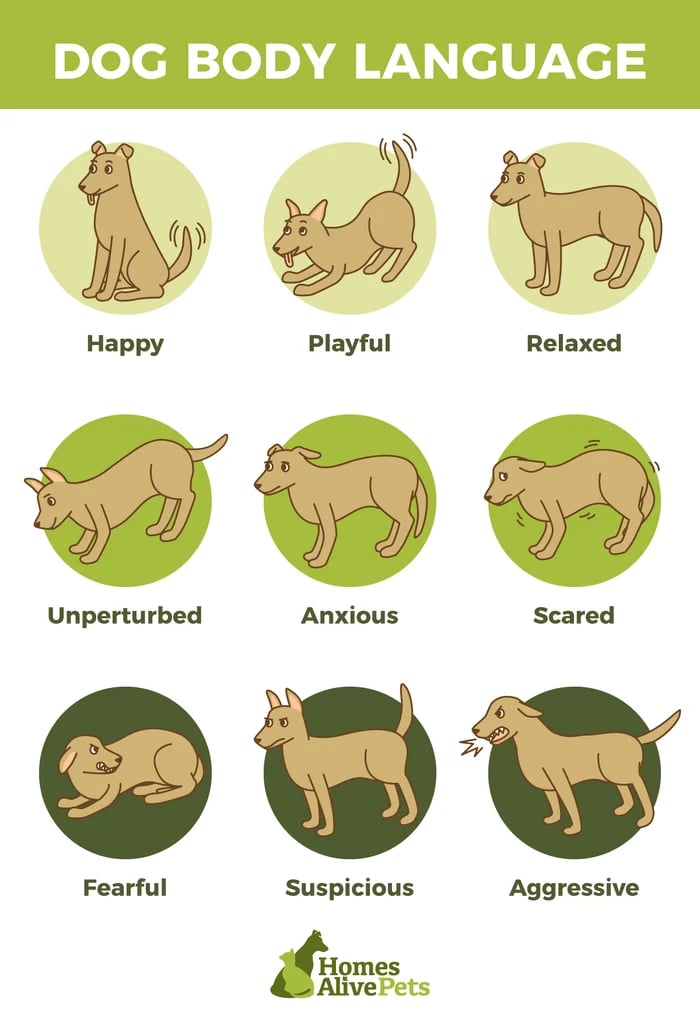
Learn more about understanding your dog's behaviour in How to Understand Dog Body Language.
Positive Body Langauge from Dogs and Cats
On occasion, when you first introduce a dog and cat, the pets will immediately find a balance and become comfortable with each other. This is usually true when dogs or cats have been raised around each other. Their body language can also display signs of positive interactions, playfulness, and confidence.
Watch for the following positive signs that show your feline and pooch are comfortable and relaxed:
-
- Ears forward
- Soft gaze
- Relaxed whiskers
- Mouth slightly open
- Raised tail
- Slight curving to the lips
- Loose muscles
- Slow breathing
Remember that an animal's personality is often unpredictable when learning how to introduce a cat to a dog. The dog or cat might seem okay together but then change quickly, especially in a new situation, like if you let the animals into another room of the house or outside.
It's also important to note that any body language signs from either pet, whether they are positive or negative, don't guarantee an action or intention. It's easy to overlook or misinterpret animal body language, especially if you go into the situation with your proverbial hackles up.
Take note of body language changes, but don't react prematurely. Multiple body language signals will be more indicative of a possible action than a single sign.
Cat and a Dog Introduction Steps

Any time you introduce a cat and dog, it can be a stressful situation. Indirect introductions are always recommended for dogs and cats that are used to being only fur children. This is a safe way for them to smell and see each other without being able to physically interact.
Every pet is different, so the introduction process is going to take as long as it takes. The following steps are a great foundation for introducing dogs and cats. Each step should be practiced until both animals are comfortable enough to move on to the next.
Best Way to Introduce a New Dog to a Cat
Before you get started, make sure you read through and understand each step. While some pets may move through these steps at lightning speed, others may need to practice some steps for days, even weeks, to relieve anxiety and encourage a positive introduction.
1. Let the New Pet Adjust to the House.
Keep the new pet in a separate room or area of the house to allow them to acclimate. Adding the stress of a new place to the stress of meeting a new sibling might increase the chances of a negative interaction. Letting them relax in an isolated area of the house will ease anxiety.
A new cat will need at least a day to destress from her recent move. Dogs are naturally more social and will need access to their outdoor bathroom areas, so if the dog is the new resident, choose an area of the house that doesn't need to intersect with your cat's territory.
2. Let Them Smell Each Other.
Before they meet, swap items that hold the other's smell. A blanket or bed, a collar, or even a plush toy will help the pet's dog bed familiarize themselves with each other's scent and pheromones.
3. Let Them Meet with a Barrier
Once they know each other's smells, the next step is to let them see each other. Using a pet gate is a great way to let the animals meet without being able to touch each other. They can see and smell but won't be able to make contact. There may be some hissing, barking, or whining at this point, but with practice, this should dissipate.
Another option is to place one pet in a comfortable pet carrier or kennel and allow them to meet through the bars or door of the carrier.
4. Choose a Neutral Area for the Introduction
Pick a room that is neutral to both pets. Ideally, an area with some open space for visibility also has areas where each pet can retreat if they feel overwhelmed. For cats, that usually means high ground, like a cat tree. If your dog is kennel trained, you can leave an open kennel for him to go to.
5. Grab a Partner
It can be challenging to monitor both animals at the same time. You are looking for different body language cues between cats and dogs and need to be able to monitor both of the movements around the room. Having a second set of eyes can increase the chances of catching extreme signs of stress before things escalate.
6. Keep the First Meeting Short
The first few meetings will be the most stressful, so set stick to short meetings and gradually increase the time together as they become less hesitant. A maximum of 5 minutes for the first meeting is recommended, though it may be shorter if either pet shows significant signs of distress.
7. Avoid Holding Either Pet in Your Arms
Though you may feel more comfortable if both pets are being held, they will likely not. Holding the pets can make them feel trapped and could provoke a fearful or aggressive response. Remember that you always want to keep safety in mind for you and your pets.
8. Use Treats to Associate a Positive Experience
Rewarding your pets with a tasty snack can be a great way to help reduce anxiety and help the pets associate the experience with a positive feeling. Choose small but flavourful treats, like Benny Bully's Liver Chops or a soft and chewy dog treat that can be fed constantly throughout the first few meetings. If you have two people, then each of you can be treating the pets simultaneously.
*Note - some animals, especially cats, may not choose to take a treat if they are feeling very stressed. That's OK. Just stay calm and use reassuring verbal and body language to help keep your cat calm.
9. Be Prepared to Stop
If the dog or cat should display signs of aggression, then redirect or remove the animal from the room and end the meeting. A negative interaction is easier to prevent than to correct. Don't get frustrated or try to discipline either pet. Just calmy remove them both from the neutral zone.
10. Let Them Choose Their Boundaries
Some dogs and cats need to learn their boundaries by testing them. Of course, you should intervene if either animal is showing too much aggression but try not to overreact. As your dog and cat get brave enough to close the distance between each other, things may start to look a little more tense.
Monitor them closely, but try not to discourage them from self-soothing and coming to a mutual understanding. If your first attempts at introducing produce nothing more than tolerance of each other's presence, that is a win. In time, that tolerance may change to friendship or stay as is.
Introducing a Puppy to a Cat
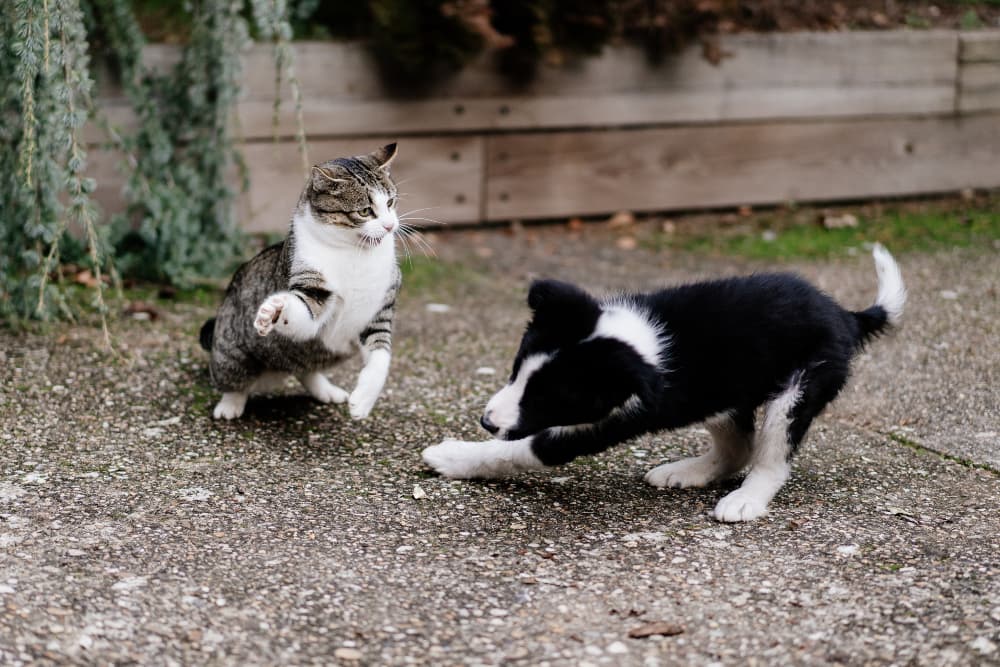
You might think it's going to be easier to introduce a puppy to a cat, but it’s not without challenges. A playful young pup might not sense the danger from an adult cat. All the puppy wants to do is chase, chew on, and play with the cat. However, an adult is unamused and might take a swipe at the small pup with its claws.
Puppies often have a very social personality, while cats can be more territorial. It's possible your adult cat may be tolerant of a goofy puppy, considering them annoying but harmless, but more often than not, an overly excited, bouncy puppy might initially come off as intimidating or pushy.
Keeping your puppy on a leash during the first few interactions can be a good way of letting your cat decide when he or she wants to interact with your pup. This will keep your puppy from charging or pawing your cat. Treat training and vocal cues, like sit or wait, can be used at this time to help teach your puppy to stay calm.
Many basic dog training techniques are useful in teaching your dog good manners. Recall training for dogs and other force-free training techniques are part of teaching your puppy the rules and how to interact with others.
Use distractions, like squeaky dog toys, freeze-dried dog treats, or a gentle belly rub to redirect your puppy if he is getting too excited.
Give your cat access to areas that your puppy can't reach. This way, when you are ready to let your pup off-leash, your cat has a safe space to retreat to if your puppy gets too pushy.
Reward Positive Behavior
With enough practice, your puppy will eventually be desensitized to the excitement of a feline sibling. Though your cat may still choose to give the puppy a wide birth, you should encourage your puppy to respect your cat's space. When your pup leaves the cat alone, treat him or praise him.
This will help them learn to co-exist peacefully and respect each other space and routine.
Introducing a Kitten to a Dog
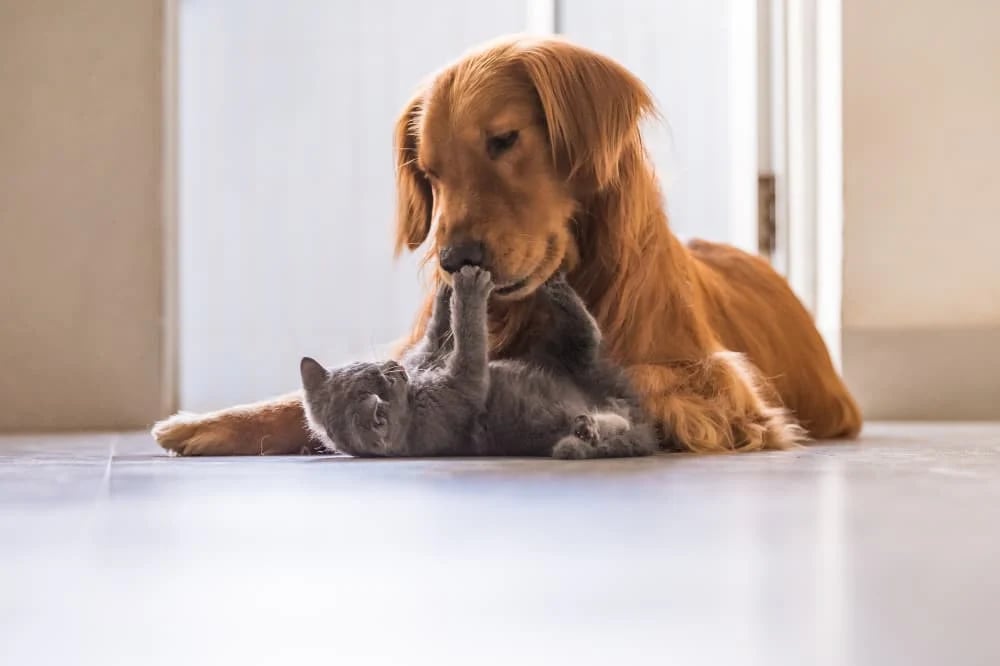
A young kitten is usually fearless, so you’ll have to watch your dog carefully. Your kitten might want to run and play, which could inspire the dog’s natural prey drive. Even if your dog gets along well with an adult cat, a kitten is so small that the dog might pose a danger to the baby animal, especially if your dog is high-energy.
The pooch might accidentally injure or kill the kitten just by trying to play with the delicate feline. Until both pets understand the other's play style and boundaries, they should never be left together unattended.
Kittens can often be cheeky once they feel comfortable with your dog. They may act tough by pouncing on or nibbling on your pooch. This is unlikely to cause your dog any pain, so teaching him tolerance is important. He's much bigger and stronger, so teaching the word gentle is a great way to help him show restraint during playtime.
Have a variety of cat toys nearby so you can redirect your kitten's excess energy to a durable toy that can take the beating, like a Mad Cat Bacon Kicker or the Kong Kitten Kickeroo.
What To Do When Leaving Pets Alone Together
Until you are sure that both pets are comfortable with each other, it's best to keep them separated when they are alone.
Eventually, you’ll probably have to leave your dog and cat alone together. You cannot micromanage every interaction. However, you can take the time each day to oversee short meetings between the dog and cat.
There is no set time that must pass before you can comfortably leave your dog and cat alone together. It might take days, weeks, or months to establish a semblance of a relationship. For some pets, it may even be never.
Once the pets no longer appear stressed, scared, or aggressive, leaving them loose together is usually okay. Always ensure your cat has an escape plan, such as cat trees or shelves where the cat can retreat if the dog starts to annoy the feline.
Leaving them locked in a small area of the house is not recommended. Instead, give them multiple areas so that each pet can comfortably have their own space. Make sure each pet has plenty of activities in their separate spaces too. Interactive Toys are a great way to keep them busy and reduce stress.
Co-Feeding the Dog and Cat Together
Some pet owners use food to build a relationship between a cat and a dog. Once your pooch and feline appear to tolerate each other, it's time to try building a relationship. Co-feeding is a fantastic way to reinforce the positive. Feed your dog on one side of the room and the cat in the opposite area.
Every day, move the food bowls closer together. Always supervise the process. Co-feeding helps the animals associate the meeting and co-existence with someone pleasant and pleasurable.
Feeding time can leave your pets feeling vulnerable, as they would be in the wild. Don't rush or force this technique, especially if either pet is too food-motivated. They may try to steal food from each other, which could lead to an altercation.
Always monitor the animals during mealtime. Scheduled feeding is recommended for multi-pet families, as leaving food out can lead to your dog eating cat food or vice versa.
What if Your Cat and Dog Do Not Get Along?
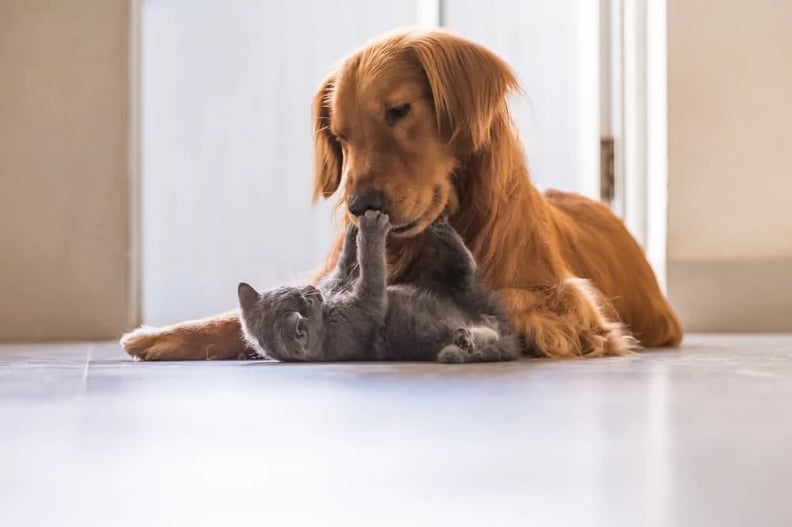
Sometimes, cats and dogs simply will not get along. You might have to start introductions all over again or keep them separated permanently. This isn't ideal, but it may be the safest option.
If this is the option you are left with, then try to give each pet an appropriate space and environment. You may think cats need less space, but a restricted environment can lead to behavioural issues. Each pet should be given multiple rooms and a dynamic environment to explore.
Keeping your pets separate can also end up getting different levels of attention and interaction. Avoid limiting one pet to a lower activity area of the house where they would receive less care and attention, like a basement.
Another option is to contact a Certified Behaviour Consultant for canines or felines. A professional will evaluate your home and lifestyle to offer advice on training to overcome behavioural issues. This could save you from having to give up one of your beloved pets.
Slow and Steady Wins the Race

In time and with patience, most dogs and cats will learn to coexist together in peace. In fact, many actually become friends. The animals will keep each other company and offer each other new ways to interact and play.
They are very different creatures, and when they get along, can complement each other. Dogs are often more active and can encourage more exercise and stimulation. Conversely, cats are excellent groomers and are often happy to supplement your dog's lack of grooming skills.
Slow introductions are always recommended, but you know your pets best, so let their behaviour and body language determine how quickly you can move on to the next step.
Frequently Asked Questions
How should I prepare my home for introducing a new dog to my resident cat?
Start by setting up separate spaces for each pet, complete with food, water, and litter for the cat and designated areas for the dog. This ensures both animals have their own safe zones.
What's the best way to introduce my dog and cat for the first time?
Begin with a gradual introduction, allowing them to see and sniff each other in a controlled setting. Use a leash for the dog and let the cat approach at its own pace.
How can I ensure a positive initial interaction between my dog and cat?
Keep the dog on a leash and use treats to reward calm behaviour. Allow the cat to approach and retreat as your furry friend feels comfortable.
What signs of stress or aggression should I watch for during introductions?
Look out for growling, hissing, raised fur, stiff body posture, or aggressive lunging. If any of these behaviours occur, separate the animals immediately.
How can I help my dog and cat build a positive relationship over time?
Gradually increase their supervised interactions, always reinforcing calm and non-aggressive behaviour with treats and praise. Keep these sessions short and pleasant.When is it safe to leave my dog and cat together unsupervised?
The timeline varies for each pair. Only consider unsupervised time when both pets are truly comfortable and peaceful together.
.png?width=200&height=66&name=logo%20(1).png)




